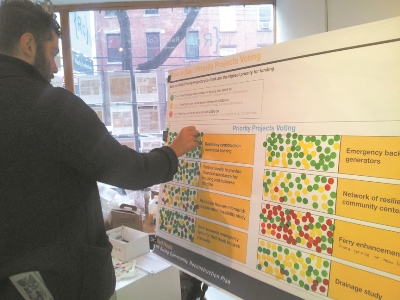Red Hook residents suggest post-Sandy projects for funding

The modest Realty Collective storefront at 351 Van Brunt Street in Red Hook was packed with people from across the neighborhood and borough, all united once again behind the desire to improve and strengthen their community following the devastation that Superstorm Sandy wrought on the waterfront neighborhood where they live, work and shop.
They were there to participate in the Red Hook NY Rising Community Reconstruction Program Open House, held on Saturday and Sunday, February 22 and 23, to get people to choose which post-Sandy storm preparedness/climate resiliency projects should receive $3 million in state funding.
There are eight possible projects ranging from support for community centers ($1-3 million) and ferry enhancements ($750,000-over $1 million) to a feasibility study for creating a locally powered energy grid for the Red Hook Houses ($300,000) and a drainage study (cost TBD).